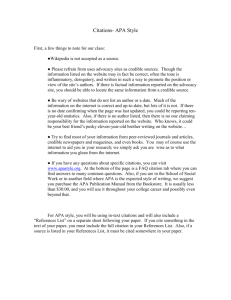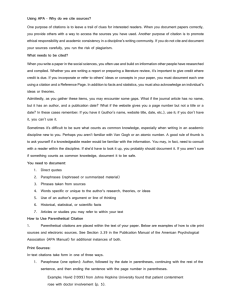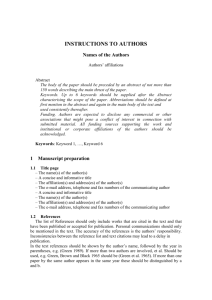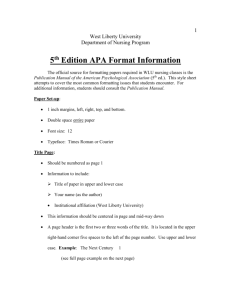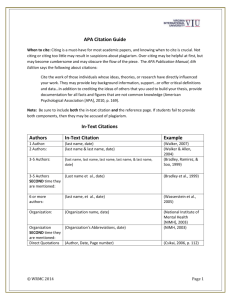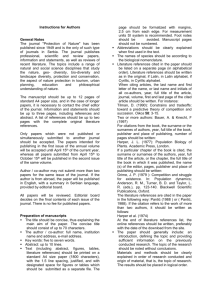American Psychological Association (APA) Citation Style
advertisement
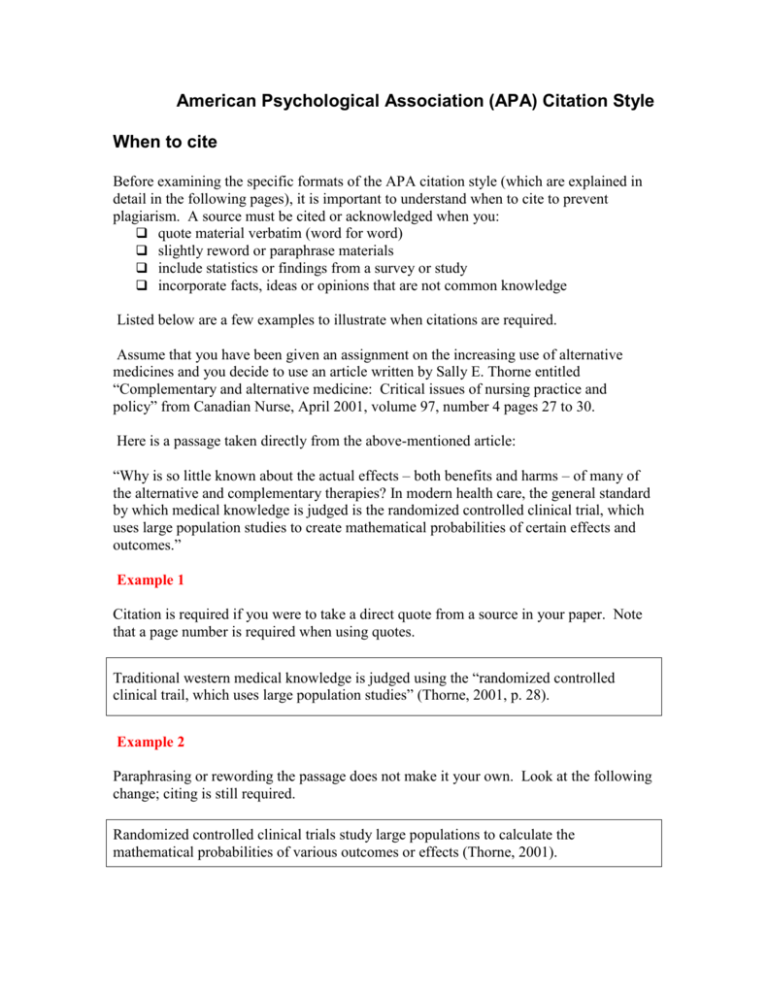
American Psychological Association (APA) Citation Style When to cite Before examining the specific formats of the APA citation style (which are explained in detail in the following pages), it is important to understand when to cite to prevent plagiarism. A source must be cited or acknowledged when you: quote material verbatim (word for word) slightly reword or paraphrase materials include statistics or findings from a survey or study incorporate facts, ideas or opinions that are not common knowledge Listed below are a few examples to illustrate when citations are required. Assume that you have been given an assignment on the increasing use of alternative medicines and you decide to use an article written by Sally E. Thorne entitled “Complementary and alternative medicine: Critical issues of nursing practice and policy” from Canadian Nurse, April 2001, volume 97, number 4 pages 27 to 30. Here is a passage taken directly from the above-mentioned article: “Why is so little known about the actual effects – both benefits and harms – of many of the alternative and complementary therapies? In modern health care, the general standard by which medical knowledge is judged is the randomized controlled clinical trial, which uses large population studies to create mathematical probabilities of certain effects and outcomes.” Example 1 Citation is required if you were to take a direct quote from a source in your paper. Note that a page number is required when using quotes. Traditional western medical knowledge is judged using the “randomized controlled clinical trail, which uses large population studies” (Thorne, 2001, p. 28). Example 2 Paraphrasing or rewording the passage does not make it your own. Look at the following change; citing is still required. Randomized controlled clinical trials study large populations to calculate the mathematical probabilities of various outcomes or effects (Thorne, 2001). Example 3 Statistics must always be cited. This example will use an article by Kathryn Wilkins and Marie P. Beaudet titled “Changes in social support in relation to seniors’ use of home care” from Health reports, Spring 2000, volume 22, number 4, pages 39 to 47. The cited statistics are from a chart within the article, which indicates that approximately 6% of seniors entering home care by 1996/97 are considered to be in a higher income bracket, while 12% are considered to be in a lower income bracket. In 1996/97 twelve percent of seniors entering home care for the first time were from lower income brackets compared to six percent from higher income brackets (Wilkins & Beaudet 2000). Example 4 Now consider another section taken directly from the Wilkins and Beaudet article: As expected, age was independently predictive of entry into home care. The odds of entering government-supported home care were three times as high for people aged 75 or older as those for 65 to 74-year olds. When you summarize a concept that is not common knowledge for your reader, you must cite your source. Regardless of income or family structure, the age of an individual is a strong factor in the decision to enter a government supported care facility (Wilkins & Beaudet, 2000). It is not necessary to cite information that is widely known by your audience – such as: “milk is a good source of calcium” or “good oral care prevents tooth decay”. What to Cite The previous examples were taken from journal articles but proper citation applies to all types of formats including books, journals, newspapers, works by associations or corporations, encyclopedias, dictionaries, technical reports, videocassettes, websites, electronic journal articles or interviews. With all this concern over plagiarism, students often complain that their essays will simply be a string of cited lines and paragraphs. However, it is how you interpret the information from various sources and bring it together, that is uniquely yours. No other individual will come up with quite the same combination. If you are in doubt if a citation is required, it is better to cite more often then not. Reference Citations In Text Information from other sources must be acknowledged within the body of the text and at the end of the paper. References within the text are brief and include the author’s name, year of publication, and page numbers where appropriate. These short references provide enough information for the reader to locate the full citation in the reference list at the end of the paper. The reference list then provides enough information to identify or locate each source. It is important that all references cited within the text must appear in the reference list, and vice versa. Below are some common APA style examples of how to provide reference sources within the text and a few tips on formatting your paper. For complete information and an exhaustive list of examples please consult the Library’s copy of the Publication Manual of the American Psychological Association held in the Reference section – Call number: BF 76.7 .P83 2001. a. b. c. d. e. f. g. h. Works by one author Works by multiple authors Works by groups Works with no author Works by the same author and the same publication date Work discussed in a secondary source Quotations Personal Communications Works by one author The surname of the author and the year of publication are inserted in the text at the appropriate point. In an earlier patient survey (Wilson, 2001) In the name of the author appears in the sentence, only the year is required in the citation. Wilson (2001) surveyed patients Works by multiple authors Use both surnames when citing a work by two authors. Use an ampersand (&) to join the names. Test antigens are injected and the response is noted at 24 and 48 hours (Skeleton & Litwack, 1999). For a work written by three to five authors, cite all the authors and first time the reference appears. Wilson, Miller, Jansen and Cohen (1997) concluded For subsequent citations, use the first surname followed by et al., a term meaning “and others”. The typical your offender is the product of a dysfunctional family characterized by both physical and emotional abuse (Wilson et al., 1997). When there are six or more authors, in all incidents use only the first person’s surname followed by et al. The Only exception is when two distinct references shorten to the same first author. In this case list enough subsequent authors to establish a distinction between the two references. Works by groups (associations, corporations, government agencies, etc.) When citing a group author, the full form of the group’s name is written out in the text citation. A deficiency in serotonin function is associated with “more than 70% of psychiatric problems including depression, anxiety, panic disorder and aggression” (The Ontario Mental Health Foundation, 1995, p. 13). If the group’s name is very long or if the abbreviation is easily recognized, the second and subsequent citations can use the abbreviated form of the group name (OMHF, 1995) Works with no author When a work has no author use the first few words of the source’s title (omitting articles such as a, an, the) and the year. Use quotation marks to surround the title of a journal article or chapter, and italicize titles of periodicals, books, brochures or reports. (Nursing theory, 1998) Works by the same author and the same publication date Identify works by the same author and the same publication date by the suffixes a, b, c, d, etc. after the year. The lower case letters places after the year should also appear in the references given in the reference list. (Rickman, 2000a) (Rickman, 2000b) Work discussed in a secondary source This occurs when a primary (or original) source has been cited in the source you are citing. For example, Miller and Grey’s work is cited in Greenberg, but you did not read the original paper by Miller and Grey. Within the text, you can mention the original source (Miller and Grey) but only the secondary source can be listed in the citation (Greenberg). Similarly, since Greenberg is the source you actually consulted, only Greenberg will appear in your reference list. You cannot cite works that you have not read firsthand. Miller and Grey’s study (as cited in Greenberg, 1997) Quotations Whenever possible, acknowledge your source with the author’s surname, year of publication and page numbers. In the case of electronic sources, such as web pages or electronic journal articles, that do not provide page numbers, the paragraph number is used instead. Use the symbol ¶ or the abbreviation para before the paragraph number. (Roberts & Smith, 1988, p. 52) (Caldwell, 2002, ¶ 6) If your quote is short – fewer than forty words – it should be incorporated into the text and enclosed by double quotation marks. e.g.: Especially if you are pressed for time, it is so easy to fall into the trap of passing off another’s work as your own. Remember that “Plagiarism is theft. Plagiarism is copying. Plagiarism is the failure to acknowledge borrowed material. Plagiarism is illegal, immoral and punishable (usually by failure, in some colleges by expulsion and in the business world by legal action)” (Coggins, 1977, p. 32). Longer quotations of forty words or more are offset from the main body of the essay by indenting five to seven spaces from the left margin. If the quotation is more than one paragraph, indent the first line of the second and subsequent paragraphs five to seven spaces from the new margin. Do not use double quotation marks. The quotation should be double-spaced. e.g.: The astute professional healthcare provider knows that informal caregivers of AIDS patients include partners, spouses, and parents … siblings, in-laws, stepparents and friends. It is important to realize that HIV is a family disease and that more than one member of the family may be infected. Sometimes caregivers are dealing with their own infected status while they are caring for their significant other. This serves to increase the burden and stress (Bradley-Spring, 1995, p. 143). If you wish to omit material in the quotation use ellipsis points (…) to indicate the location of the absent material. Use three special ellipsis points for omissions within a sentence and use four points for omissions between two sentences. Take care to ensure that the material omitted does not change the original meaning of the quoted passage. Personal Communications Personal communications can include letters, memos, emails, personal interviews or telephone conversations. Unlike published sources, personal communications are only cited within the text and not in the reference list at the end of the paper. These sources are not in the reference list because they are not recoverable data. In the text reference, the initials and surname of the communicator should be included as well as an exact a date as possible. The APA guidelines do not require that you specify the type of personal communication (email, interview, etc.). PLEASE CHECK WITH YOUR INSTRUCTOR IF PERSONAL COMMUNICTIONS ARE ACCEPTABLE SOURCES FOR YOUR PAPER OR IF THEY HAVE ANY ADDITIONAL REQUIREMENTS IN ADDITION TO THOSE OUTLINED BY THE APA. (P. K. Smith, Personal communication, October 23, 2003) REFERENCE LIST As previously mentioned, the references cited within the text of a paper must also appear in the reference list. This list provides enough information for each source to be identified and retrieved, and must contain all the resources used in the paper. Do not include references that were not cited within the body of the paper. The reference list should start on a new page and the word References should be centered a t the top of the page. All reference entries should be double-spaced. APA uses a hanging-indent format – the first line of each entry is flush left and subsequent lines are indented (see format of the examples below). Entries should be arranged alphabetically by author’s surname or name of a corporate body. If the author is unknown, alphabetize the entry in the list by its title. Elements that must be contained in reference list citations include author name, titles, date of publication and publisher information. Below are some common APA style examples of how to provide reference list citations (these examples are not double-spaced in order to save space). Note the type of information included in a bibliographic entry and its specific order. Also pay attention to correct punctuation. For complete information and an exhaustive list of examples please consult the Library’s copy of the 5th edition of the Publication Manual of the American Psychological Association held in the Reference section - Call number: BF 76.7 .P83 2001. Books No author Dorland’s illustrated medical dictionary (29th ed.). (2000). Philadelphia: Saunders. One author Coggins, G. (1977). A guide to writing essays and research papers. Toronto: Van Nostrand Reinhold. Two authors Gage, T. W., & Pickett, F. A. (2001). Mosbey’s dental drug Reference (5th ed.). St. Louis, MO: Mosby. Multiple authors Cite all authors up to and including six authors. If a book has more than six authors, cite the first six and abbreviate the remaining authors as et al. Kirton, C. A., Talotta, D., & Zwolski, K. (2001). Handbook of HIV/AIDS nursing. St. Louis, MO: Mosby. Edited book Barton-Burke, M., Wilkes, G. & Ingwesen, K. (Eds.). (2001). Cancer chemotherapy: A nursing process approach (3rd ed.). Sudbury, MA: Jones and Bartlett. Corporate author, author as publisher Corporate publications (e.g. annual reports) are often published by the corporation itself. In these cases the publisher is listed as Author and the place of publication is often the city of the corporation’s head office. World Heart Corporation. (1997). 1997 annual report. Ottawa: Author. Works by the same author with the same publication date Identify works by the same author with the same publication date by the suffixes a, b, c, d, etc. after the year. Canadian Dental Hygienists Association. (2002a). Corporate opportunities. Retrieved September 30, 2003 from http://www.cdha.ca/content/corportae_opportunities/corporate_opportunities.asp Canadian Dental Hygienists Association.(2002b). Events &conferences. Retrieved September 30, 2002 from http://www.cdha.ca/content/event&conferences/events.asp Brochures and pamphlets Inform your readers if your source is an individual work but a small item such as a pamphlet, chart or map. The presentation format or medium appears in square brackets. Correctional Service Canada.(2000).Parole eligibly [Pamphlet]. Ottawa: Solicitor General of Canada and Public Works and Government Services Canada. Article or chapter in an edited book Abrams, A.C.1998). Antiviral drugs. In M. Zuccarin (Ed), Clinical Drug therapy: Rationales for nursing practice (5th ed., pp. 518-533). Philadelphia: LippincottRaven. Encyclopedia entry Fall, M. (1991). Chemistry. In The world book encyclopedia (Vol. 3, pp. 398-407). Chicago: World book. Periodicals Journal article references include the author of the article, date, title of the article, title of the journal, volume and issue information and the page range of the article. Journal article with two authors Wilkins, K. & Beaudet M. P. (2000). Changes in social support in relation to senior’s use of home care. Health Reports, 11(4), 39-47. Journal articles with three to six authors Head, D.W., Head, B. & Head, J.L. (1985). Life or death of Severely disabled infants: A counseling issue. Journal of Counseling & Development, 63(10), 261-264 Journal articles with more than six authors If an article has more than six authors, cite the first six and abbreviate the remaining authors as et al. Davies, B., Hodnett, E., Hannah, M., O’Brien-Pallas, L., Pringle, D., Wells, G. et al. (2002). Fetal health surveillance: A Community-wide approach versus a tailored intervention for The implementation of clinical practice guidelines. CMAJ: Canadian Medical Association Journal, 167(5), 469-474. Newspaper article with author(s) References for titles are published daily (e.g. newspapers) include the month, day and year. Unlike journal references, newspaper references also require a p. or pp. for page number(s). Robinson, L. (2002, September 10). Simple solutions to address Nursing labour shortage. The Hamilton Spectator, p. B4. Newspaper article with no author Medicated gum helpful to seniors. (2002, September 19). The Kitchener-Waterloo Record, p. C2. Electronic Sources The 5th edition of the APA style guide includes new guidelines for the citation of electronic references. However, your instructor may have a format that he/she prefers to use instead. PLEASE CHECK WITH YOUR INSTRUCTOR FOR ANY ADDITIONAL REQURIEMENTS THAT MAY DIFFER FROM THOSE OUTLINED BY THE APA. Websites College of Nurses of Ontario. (2003, July 28). Welcome to CNO. Retrieved September 20, 2003 from http://www.cno.org Journal article retrieved from Internet with print equivalent Often online journal articles are a duplication of a print version. As a result, the same primary journal reference can be used. To indicate that the electronic version was used as the source [electronic resource] should be included after the article title. Thorne, S. E. (2001). Complementary and alternative medicine: Critical issues of nursing practice and policy [electronic version]. Canadian Nurse, 97(4), 27-30. Electronic journal retrieved from journal database Full-text journal articles retrieved from EBSCO or Proquest databases are examples of this type of source. The reference will be very similar to a print journal reference, however, the name of the database and the date of retrieval are also listed. Head, D. W., Head, B. & Head, J. L. (1985). Life or death of Severely disabled infants: A counseling issue. Journal of Counseling & Development, 63 (10), 261-264. Retrieved September 20, 2002 from the EBSCO Academic Search Premier database. Electronic books Electronic book references are very similar to print book references. However, the retrieval date and the name of the source are also included in the reference. Nettina, S. M. (Ed.). Lippincott manual of nursing practice. Philadelphia: Williams & Wilkins. Retrieved September 30, 2002 from Books@Ovid. Audio-visual Material Television broadcast Provide the name(s) of the originator or the primary contributors and their function (e.g. director, producer). Also provide the date of broadcast, title, medium, place of production and the name of the production company. Mansbridge, P. (Chief Correspondent). (1998, March 30). The National [Television broadcast]. Toronto: Canadian Broadcasting Corporation. Video recording with one contributor Belson, J. (Producer). (1995). Domestic violence: Identification, treatment and referral for the healthcare Professional [Motion picture]. Glendale, CA: Belson/Harwright. Video recording with two contributors Spiegel, S. (Producer) & Martin, Q. (Director). (1982). The Heart as the primary pump [picture]. New York: Scientific Minds. Discussion Lists, Newsgroups, and Electronic Mailing Lists (Listservs) In general, discussion list messages, newsgroups and electronic mailing lists (listservs) are not referenced in formal research publications. These sources are seldom peer reviewed, often lack scholarly content and are difficult to retrieve into the future (unless archives are kept). CHECK WITH YOUR PROFESSOR IF THESE COMMUNICATION FORMATS ARE ACCEPTABLE SOURCES. If they can be included, cite them as follows: Discussion lists and newsgroups Simons, D.J. (2000, July 14). New resources for visual cognition. Message posted to http://groups.yahoo.com/group/visualcognition/messge/31 Electronic mailing lists (listservs) Spencer, T. (1999, December 7). Helpful tips for elder care. Message posted to LISTSERV&kentuckyu.nursing.edu Personal Communication Personal communications include letters, personal interviews, telephone conversations and email. APA guidelines require personal communication to be cited within the text only and do not require these sources to be included in the reference list since these sources are not recoverable data. PLEASE CHECK WITH YOUR INSTRUCTOR TO SEE IF THESE ARE ACCEPTABLE SOURCES. If personal communications are permitted, your instructor may want you to include them in your reference list to provide more detailed information about your source. If this is the case, be sure to provide information such as the source (e.g. name of sender, interviewee), the source’s organization, date of communication and type of communication. Personal interview Nesbitt, L. (President, Hamilton and District Chamber of Commerce). (1998, January 30). Personal Interview. Email Jackson, G. (jackson@aol.com). (2000, February 1). Midterm papers. Email to S.T. Withers (stwithers@sympatico.ca). Bibliography The Canadian Encyclopedia Plus, copyright © 1996 by McClelland & Stewart Inc. Gage Canadian Dictionary. Copyright © 1983 by Gage Educational Publishing Company." Clegg, S. (2000). Knowing through reflective practice in higher education. In Educational Research. 8, Greene, M. (1995). Releasing the imagination : essays on education, the arts, and social change. San Francisco: Jossey-Bass Publishers. Korthagen, F. & Russell, T. (1995). Teachers who teach teachers: Some final considerations. In T. Russell and F. Korthagen. (Eds.) Teachers who teach teachers: Reflections on teacher education. London: Falmers Press. Loughran, J. & Northfield, J. (1998). A Framework for the development of self-study practice. In M. L. Hamilton. (Ed.) Reconceptualizing teaching practice: Self-study in teacher education. London Falmer Press. Strickland, D. (1988). The Teacher as researcher: Towards the extended professional. In Language Arts. Vol. 65 #8. Hildyard, A., & Wells, G. Action research in Ontario schools. Orbit. # 29, 3. OISE.
